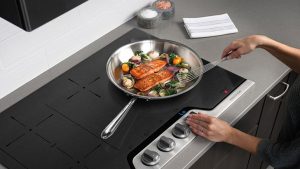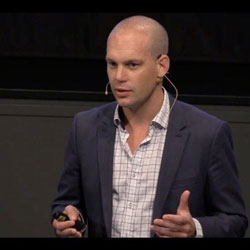
Electrolux is at the early stages of deploying big data, AI and machine learning across its entire business. Vallin said: “I oversee the whole scope of, the value chain, from purchasing and components, handling our suppliers, to a little bit of logistics to fill plants and the manufacturing processes.”
One area where Electrolux is using AI is to predict demand. This allows it to tune its manufacturing, distribution and customer supply chain.
According to Vallin: “It’s about optimising suppliers, optimising incoming warehouses or logistics chains and transport. After we have manufactured, we have to supply to different parts of the world. Our customer, the retailers, need to sell them so we distribute them from our warehouses near the factory or plant to redistribution centres. That is what we call demand planning.”
External feeds provide key data streams
Tuning a supply chain requires more than just historical sales data. Vallin’s talk at Spark+AI was about how Electrolux uses its data. He spoke about how it enhances its data with that from external sources to tune its manufacturing, shipping and distribution channels. The latter also ensures that retailers have the right goods when customers are demanding them. One example, cited by Vallin, is how Electrolux uses weather data using the sale of air conditioners in Sweden.

“The most correlated variable is the weather and the temperature outside. Anyone who has tried to buy an aircon in a country like Sweden when it is peaking hot runs into trouble. This is usually because the warehouses are empty because it goes beyond a normal demand or sales volume. We are trying to do that quite successfully to predict what is the exact amount of the right products for us to put into our customer for them to optimise their business.”
It is not just weather data that affects sales. Vallin talked about how the company monitors the Internet for online reviews, ratings and the prices of products in both retail stores and online stores. A key variable that Vallin identified is price promotions by competitors. It uses this data to avoid oversupply, overstocking and the inevitable discounting by retailers this causes.
Vallin said the company uses the data: “To combine machine learning of historical data and put tools in the hands of the pricing officer and the trade marketeer to adjust the trends based on what they are sensing in the market.” It tunes the machine learning models to take into account awards, price promotions and reviews. Importantly, this is being done across thousands of products and hundreds of sales channels.
Big data creates big processing and storage demands
ET asked Vallin how much data Electrolux was gathering. Vallin said: “I can’t really say but I’ve been running this unit for 2 years now. The first half year was a lot of recruiting of staff. We have now doubled the size of all the other data centres in terms of the data we have in our data lake.”
That data set is only going to increase as Electrolux drives intelligence and connectivity into its products. Vallin said that the company has connected all of its IoT platforms. That means it has the potential to gather a vast amount of additional usage data. Some of this can be used for predictive repair and even new services.
Vallin gave the example of the ice maker on the Electrolux new connected fridge. “If you don’t handle it correctly it’s more likely to break. If we can see some consumer behaviour that could end up in that piece breaking, it’s in both our interest to give the customer a recommendation on how to clean it and how to handle it.” The goal is to prevent the customer having a bad consumer experience which would potentially impact future sales. From the Electrolux perspective this is also about reducing the number of warranty calls.
New models mean new service opportunities
Electrolux is also using the data to build new service models. One of these that mirrors other industries is renting or subscription rather than outright ownership.
Vallin said: “I created one of the use cases together with other business units. To get a full 360 degree view of the robotic vacuum cleaner and what is happening etc, we created a new business model. You can rent but not for a normal subscription fee but actually the number of square meters it cleans.”
This consumption model is similar to how many engineering companies are delivering products. Aircraft engine manufacturers now sell engines based on miles flown. They also use digital twins to adjust maintenance schedules.
Vallin believes that this will appeal to customers. “If it doesn’t do the job, create a value for you, it doesn’t cost you. There is a minimum fee of course and I think we are planning to replenish the whole supply of brush rolls and filters to make sure it is effortless and a fantastic consumer experience to get a clean home rather than pay for an appliance.”
Another example Vallin gave is: “If you would have a Chanel dress that costs €1,000 and the opportunity to upgrade the washing machine cycle program for one that is optimised for that particular type of dress that is approved by Chanel and it costs you just 1 euro, you would probably invest in that. We can’t make programmes for everything when we ship it but we can learn from the consumers and work with the fabric manufacturer and begin to create added value.”
A glimse into the future
Vallin is a data scientist and runs a team of other data scientists. He says his job is about designing algorithms for smart systems. He has a personal vision of where IoT, smart devices and even smarter algorithms can go.
Imagine your smart oven knowing how many people you are cooking food for. If you are cooking a normal meal then it just helps with the cooking. Vallin asked: “What if it detected that there is food for 16 people in there? The decision could be you are either cooking for the whole week or you are going to have guests.”
This is where connectivity gets interesting. In Vallin’s example, if this is a Saturday morning or Saturday afternoon it is reasonable to conclude they are having guests. This means the system could trigger the robotic vacuum cleaners before the guests arrive.
Vallin went further to look at how this level of collaboration between devices is not limited to a single manufacturer. He said: “We might then purify the air because of the particles from the vacuum cleaner. Maybe before we even clean the air we send a signal to the vendor of the window opener to ventilate some of the air out. Then we close the windows and run the purifier and start the air conditioner for the optimal temperature for when the guests are coming.”
This is not just about home support systems. The home AI could even ask who the guests are. It can then connect to streaming music services and find out what those guests listen to. The result is a customised play list for the evening.
Vallin was quick to point out that this is his vision and that Electrolux is not yet building such systems. Nonetheless, it is a compelling glimpse of the future.
What does this mean for security, privacy and consent?
The Rick Osterloh, Head of Devices, Google was recently asked if he would tell guests that he had smart systems in his house that could capture their voices. He replied yes. That response raises some significant future challenges, especially as we already have evidence how the misuse of some systems by vendors. Taking the above example, we asked Vallin how Electrolux would protect privacy.
Vallin said: “Electrolux has intentionally fallen behind the competition like Samsung and LG in the smart home space because we have put a lot of energy in this security architecture and framework. This is taking place in the connected appliance, both the electronics, the firmware, the software, everything, the whole chain and keeping that intact and up to speed before we roll out smart appliances.”
Unfortunately this isn’t Vallin’s area of expertise which meant he couldn’t talk about what the company is doing in detail. However, the fact that Electrolux has taken a step back to focus on security and privacy, rather than chasing market share with new products, is an interesting approach.
Ownership of data is important to Vallin and he believes that individuals should own their own data. He said: “The way I want to do it in Electrolux is that first of all we need consent. Secondly we need to create value. But thirdly it needs to be ethical and well thought through. We need to think for the consumer a little bit. Then the last piece is that they should almost expect us to do something any my example is the predictive maintenance on the appliance.”
Enterprise Times: What does this mean
Using big data, AI and machine learning to improve the business is something that all vendors are looking to do. The winners will be those who create value out of what they do rather than just end up with more processes that are not flexible enough to adapt to changing business conditions. Vallin has set out a very clear view of how Electrolux is using technology to gain an advantage.
Manufacturers are quick to add new features and technology if they think it will increase sales. In the consumer space this is all too often poorly thought through and does not take into account the wider implications. This can be seen from the problems we are currently having with insecure devices inside homes as manufacturers have rushed to connect them to the Internet.
That Electrolux was willing to give up market share to get security and privacy right is a brave move. Whether it will pay off in the long run will depend on consumer attitudes. At the moment, there is still a willingness to buy something cheap without considering the implications. Judging by the conversations at industry event, however, that is changing. The long game that Electrolux is playing here may yet turn out to be a very smart bet.
If Vallin’s vision of how AI and connected systems from multiple vendors will come to fruition in the home is to come true, privacy and security are key requirements.
This is not just about the home. What happens in the consumer space inevitably happens in the enterprise. Can Electrolux translate its home vision to the enterprise? From what Vallin told ET, there is every reason to be confident in the future.


























